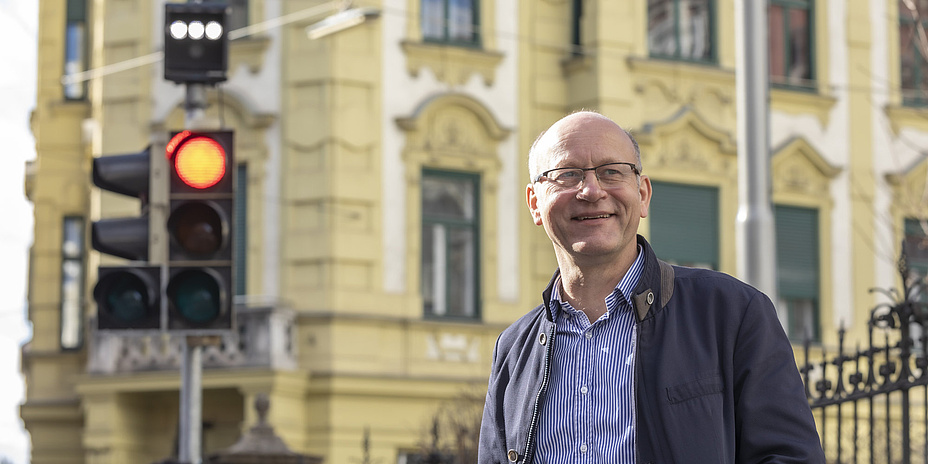“I can’t install 100 wall boxes in a block of flats with 100 parking spaces”

News + Stories: Does the increase in battery electric vehicles (BEVs) also have an impact on transport planning, or is a vehicle simply a vehicle in this context?
Martin Fellendorf: The often-declared positive effects are in some respects overestimated, because a vehicle is still a vehicle, and traffic jams are still ubiquitous. There is no gain in space. Of course, the increase in BEVs has implications for transport planning – because of air pollutants, especially in the city. Currently, this is not a big topic in the media, but a few years ago we had public discussions in Graz about particles and nitrogen oxides. With electromobility, this issue is becoming less important, but in the wake of climate change, fossil fuel consumption is a very relevant topic. If vehicles are charged with green electricity in the future, e-mobility naturally offers great opportunities, though traffic quality and the performance of transport networks are hardly improved by e-mobility in itself. But another factor that should not be neglected are the charging stations. This is different from the current situation with petrol stations.
How big do you have to expand the charging infrastructure for e-mobility to work on a large scale at all? Especially if it gets to the point where at least individual transport is completely electric.
Fellendorf: If everyone were to drive electric vehicles, our charging infrastructure would have to be expanded at an immense pace. For two reasons. Our electricity grids do not currently offer the capacity, although I am not the appropriate contact person for grid expansion. But we would not only need much more low-voltage supply for household electricity, but also more medium-voltage supply. In large residential complexes, it is currently not possible to equip every parking space with a wall box for simultaneous use. If I now have a block of flats with 100 parking spaces, I cannot install 100 wall boxes there and at the same time offer everyone eleven or 22 kW of charging power. A supply line with only household electricity will not be sufficient. Charging management, portion-wise allocation of charging power – i.e. rationing – will then be necessary or else the electricity industry will have to increase its power according to demand.
If we look back, supply infrastructure never ran smoothly at the beginning even in the development era of combustion engines
Fortunately, a standardisation of charging plugs with the CCS plugs has been established in Europe in the meantime, with which both alternating current up to 22 kW and direct current with higher charging power can be charged. However, if we look back, supply infrastructure never ran smoothly at the beginning even in the development era of combustion engines. When Bertha Benz set off on her legendary journey in 1888, she had to go to the drugstore to fill up on cleaning solvent. In the following years, fuel was still sold in canisters and arbitrary containers in pharmacies, drugstores and general shops without special safety precautions. The petrol station network in Austria was not established until the mid-1920s, several decades after the invention of the car. It just took its time and we are experiencing the same thing now with electricity refuelling.
We still have a completely different problem in Europe with the lack of a consistent tariff system for charging electricity. When I drive to a petrol station, it doesn’t matter who I fill up with. I can always pay with the same credit card or cash. This is currently not possible at charging stations, as the operators issue their own charging cards. There are now solutions for EV charging roaming, but unlike mobile telephony, this often involves exorbitant additional costs. The cheapest way to charge is at home, provided you have your own charging connection. The costs at a fast-charging station are often over three times more; it should also be noted that with public charging, time costs are often charged for using the charging station in addition to consumption costs.
The time factor is always important when refuelling or charging. Filling up is relatively quick, but charging takes time. To what extent does this affect infrastructure requirements and planning?
Fellendorf: This definitely has an impact and the time factor also affects the offered charging capacities. For example, the charging capacity is being constantly increased at the fast-charging stations, though these should not be used so often because of the battery life. If these stations now charge at 150 kW instead of the 11 kW at the wall box at home, less than a tenth of the time is needed. These fast-charging options are being expanded, so charging is done within the time it takes to drink a cup of coffee and no longer takes as long as an entire lunch.
Vehicles with hybrid powertrains should only be considered as an intermediate technology
Is the expansion of the charging infrastructure progressing as fast as the use of electric vehicles is increasing?
Fellendorf: Yes, the expansion is going fast enough because the use of electric vehicles is growing less overall than was thought last year. So, this is not because charging stations are being built faster, but because sales of electric vehicles are lagging behind – at least in Central Europe.
You have already mentioned the current network capacities as an obstacle to the expansion of the charging infrastructure both in the area of residential developments and in the area of fast charging infrastructure. But are costs, bureaucracy and available space also an issue for expansion?
Fellendorf: Bureaucracy is definitely an issue. It is principally technology and bureaucracy together. For example, the issue of fire protection has not yet been sufficiently clarified. Some property developers are also opposed to installing numerous wall boxes. I therefore see a need for action here in any case. In addition, a low affinity for new technology is evident in Europe. We look at the risks first before we try things out. The USA and China are way ahead of us in this respect. They just do it. And then when they see that they are on the wrong track technologically, the technology is changed. With us, everything is always weighed up for a very, very long time before a decision is made. And then it’s too late.
This article is part of the TU Graz dossier "Recharged". Find further dossiers in our overview.
When it comes to obstacles in charging infrastructure, however, we also have to talk about charging locations, which are not very attractive. In the underground car park, wall boxes don’t really matter visually, but in the public space charging points are actually a real blot on the cityscape. Of course, solutions are needed for this. A good example of this is Matrix Charging from Graz-based start-up easelink, in which a connector on the underside of the car lowers onto a charging plate and connects with it. The principle is very good, and now we need enough car manufacturers to join in. Since inductive charging does not work so well because of the charging losses, a plug-in system will be needed in any case, and if the plug-in process were to be eliminated by a system like Matrix Charging, another obstacle would be removed. I am curious to see which technology will win out on the market here.
Looking at it in general terms, do electric vehicles make sense at all for all mobility sectors? And how will this change in the future?
Fellendorf: Vehicles with hybrid powertrains should only be considered as an intermediate technology. I don’t understand why they have similar funding conditions as pure electric vehicles. Many have such low battery-powered driving capabilities that they very rarely drive electrically. This is particularly the case in the company car sector. Therefore, I see it as a sham that hybrids with low ranges around 50 kilometres are also subsidised without proof of the actual use of the electric drive.
How far are politicians really willing to pull the lever massively and restrict motorised individual mobility even more through cost increases and other regulatory push measures such as parking space management?
A real problem of e-mobility are still the long-distance trips. But this raises the question of which vehicles drive long distances frequently. If you travel long distance once or twice a year for a holiday trip and have to wait a little longer at a fast-charging station, I think that’s acceptable. For people with frequent long distance car trips, it is of course a different matter. And then there is the issue of HGVs (trucks). It is still really difficult in this area, especially in long-distance freight transport. In Germany, there have been trials with inductive charging on the motorway and with a pantograph, i.e. a current collector with which the trucks travel and charge on sections with an overhead line. Some test routes have already been closed in Germany, but the test route near Frankfurt is being further expanded. You can’t get any further with inductive charging because the charging losses are too great. And overhead lines for trucks are probably not yet technologically mature enough. In long-distance freight transport, which has a high consumption rate to boot, there is still no real solution in sight. But there are very positive trends in public bus transport, especially in the city. There, it is a question of coordinating the turning times at the end of the line with the charging times, but this certainly seems to be a technology with a promising future. In the process, the bus turning points, where there are compulsory stops anyway due to rest periods, are combined with charging times. Research is needed here in order to coordinate timetables and circulation schedules with charging operations.
Where do you see the general trend in the future? Do you expect everything to be electrified at some point? Or do you see other options that could be used to make transport as climate-neutral as possible without restricting individuals in their mobility?
Fellendorf: That’s where the big keyword mobility transition comes into play. The question always arises as to how far politicians are really willing to pull the lever massively and restrict motorised individual mobility even more through cost increases and other regulatory push measures such as parking space management? These are the two big levers one would have. And here, despite green governments in various countries, the successes so far have been rather small. Unfortunately, I think more natural disasters will have to occur before enough people realise that we have to do something.
Kontakt
Martin FELLENDORF
Univ.-Prof. Dr.-Ing.
TU Graz | Institute of Highway Engineering and Transport Planning
Phone: +43 316 873 6220
martin.fellendorf@tugraz.at




